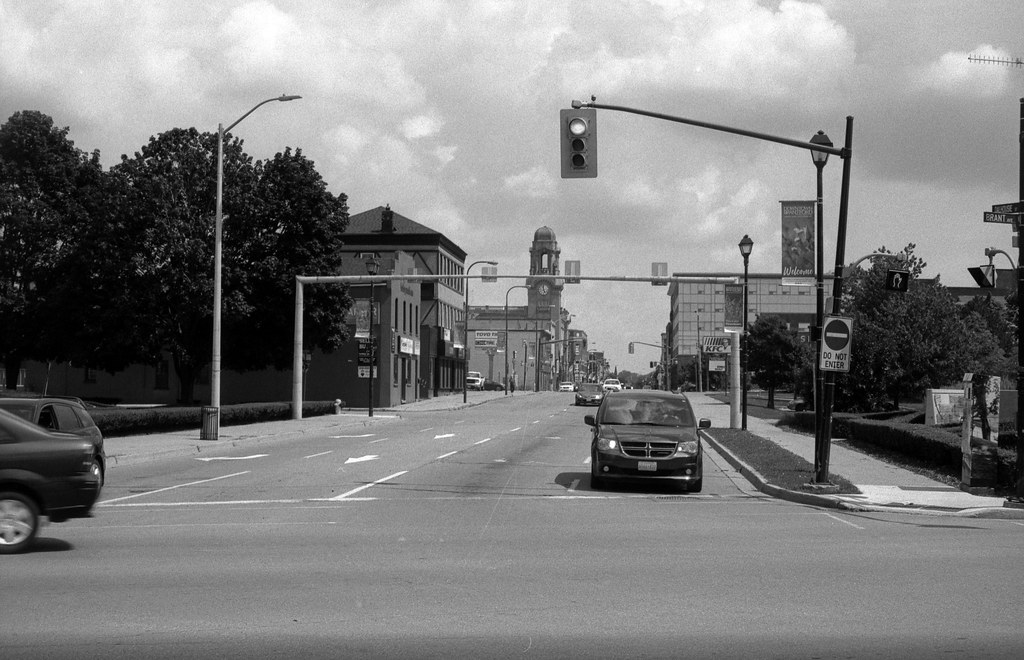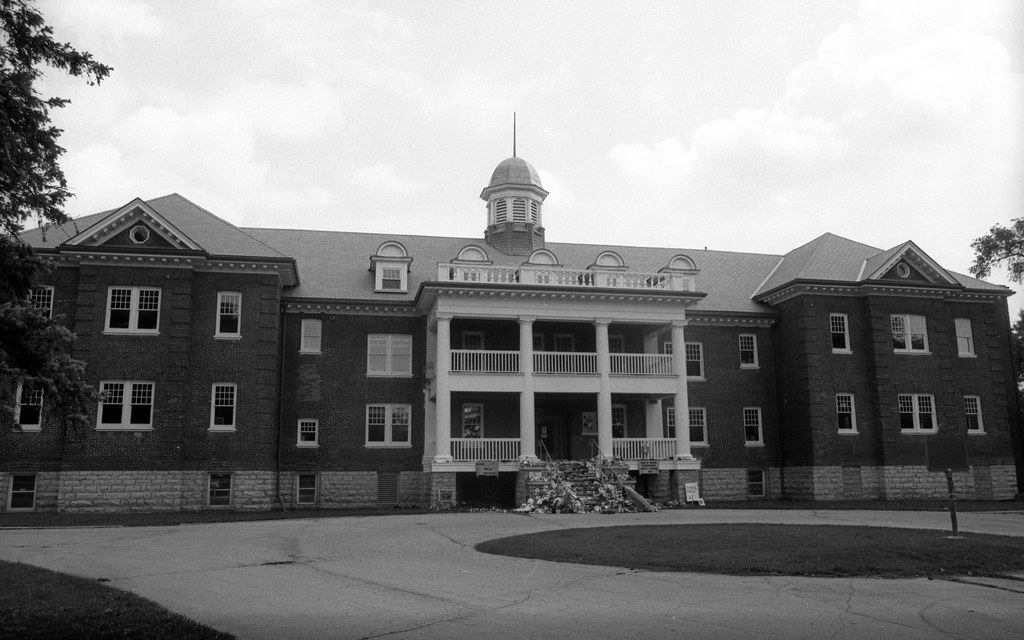My first introduction to Brantford came in the form of the film Silent Hill where the city’s depressed centre featured as the downtown of the titular Silent Hill, a fictional mining town that ended up in a supernatural cataclysm after a coal fire broke out. Brantford, in reality, has a far more complex history where the dark colonial past and rich indigenous heritage are seen like never before in Ontario. I’ll admit, this week was hard, made harder by recent dark elements of Canada that were brought to light for us on the colonial side of history.

Nikon FM – AI-S Nikkor 50mm 1:1.4 – Fomapan 100 @ ASA-100 – Adox FX-39 II (1+9) 7:00 @ 20C
The earliest known human settlement in the Grand River Valley where the modern city of Brantford stands today was the village of Kandoucho, the central village of some twenty-eight settlements of the Attawandaron. Our knowledge of this village is thanks to the diaries of French Roman Catholic missionaries, notably Reverend Father Joseph de La Roche Daillon, who lived among the people in the 1620s. The Iroquois had all been wiped out during their northern conquest during a series of battles known as the Beaver Wars and encouraged by Colonial powers in North America. In the United States, a young warrior, Thayendanegea, gained prominence among the British Colonial authorities and helped ally the Mohawk people with the British during the French-Indian War and American Revolutionary War. He then used his influence to ensure new land to replace that lost in the United States, and in 1784 secured a large tract of land in the Grand River Valley known as the Haldimand Tract. At a bend in the river, a small Mohawk Village formed known as Brant’s Ford or Brant’s Crossing. A little bit up the river, a European Settlement also formed. These two would grow through the 19th Century, especially when road access improved, and it provided shelter and new homes for former slaves escaping from the United States. Sadly the concentration of Indigenous people allowed the British authority to try a new thing, and in 1831 opened the Mohawk Institute based on ideas from Lieutenant-Governor Sir Peregrine Maitland, who proposed a series of ‘schools’ to help the Indigenous people ‘fit in’ with British culture and civilization. The Institute, operated by the Anglican Church, at least until attendance became compulsory in 1885 when the Canadian Government took over. In 1837, seeing the industrial potential of the land where the Six Nations lived, Colonial authorities annexed the land. They forced the Indigenous peoples to move to a new location further from the Institute, where most of their children were forced to assimilate through horrific means. Through the 1840s, the European settlement took even the name of the original settlement, Brantford and in 1847 incorporated as a town. The railroad’s arrival in 1854 announced further growth, and quickly an industrial base began to grow with large manufacturing industries opening along the river on stolen Indigenous land. It also was the first long-distance phone call; Alexander Graham Bell would complete the call in 1876 using traditional telegraph wires to nearby Paris. Huge manufacturing plants for Cockshutt and Massey-Harris provided a bulk of the work source for the community. The rapid industrialization allowed incorporation as a city in 1877. Despite being located so close to Hamilton, Brantford’s industrial power remained focused on agriculture but certainly provided for the Canadian war effort with munitions and even aeroplanes like the Avro Lancaster being constructed here. The Mohawk Institute closed in 1970, although by this point the school had been burned down twice during its life, with the final building going up in 1904 and turned over to the Six Nations who operate it today as a museum and cultural centre an effort to undo the damage done by the Institute. The rest of Brantford suffered through the 1980s as the factories closed in the economic downturn. The sudden and rapid deindustrialization caused mass unemployment and rapid urban decline. By 2000 the city was in a slump with the downtown a mess of abandoned buildings while the outskirts were no better with tonnes of environmental damage. The city would attempt to turn things around in 2010 with programs to expropriate these abandoned buildings. Rather than seek restoration or adaptive reuse or partial retention, they were knocked down to make room for an expanding Laurier University. Among the buildings knocked down were the original Bell Telephone Headquarters and what is believed to be the first Grocery Store in Ontario. While today the downtown is still not pretty, the homeless are everywhere. I certainly felt out of place but impressed by the number of historic buildings that still stand.

Nikon FM – AI Nikkor 28mm 1:3.5 – Fomapan 100 @ ASA-100 – Adox FX-39 II (1+9) 7:00 @ 20C
Nikon FM – AI-S Nikkor 105mm 1:2.5 – Fomapan 100 @ ASA-100 – Adox FX-39 II (1+9) 7:00 @ 20C
I’ll admit, this was a tough week, but it also gave me a bit of resolve on at least two images I had to include. While the featured image is that of the usual streetscape from downtown Brantford, it is far from my favourite, and actually, it was the last shot I took on the roll. I made a point to highlight the city’s indigenous history as much as possible. Sure it would have been easy to include shots related to Wayne Gretzky and Alexander Graham Bell. And I did get a photo of the Alexander Graham Bell Memorial; I didn’t include that in the image in favour of another architectural shot. The first two main images are of the third main building from the Mohawk Institute and the memorial to the thousands of children who never left these places of horror. And these were tough shots; I openly wept at the sight of the building and had to make peace before actually taking the shots. One surprising discovery was a memorial to Thayendanegea (Joseph Brant) in the middle of Victoria Park (named for Queen Victoria). I filled in with several architectural shots from the downtown. I was saddened with the knowledge that several amazing buildings had been torn down over a decade ago now but impressed at the buildings still present downtown.

Nikon FM – AI-S Nikkor 105mm 1:2.5 – Fomapan 100 @ ASA-100 – Adox FX-39 II (1+9) 7:00 @ 20C
Nikon FM – AI Nikkor 28mm 1:3.5 – Fomapan 100 @ ASA-100 – Adox FX-39 II (1+9) 7:00 @ 20C
Having extra room in the bag this week, I decided to run with my usual three lens kit, and I’m glad I did because I had several chances to get into some closer details. While most of the time, I went with my 28mm lens, as having that wide-angle in the downtown area certainly helped in the narrow streets. Having that 105mm did help in some cases where I couldn’t get close, such as the statue of Thayendanegea or the sad memorial to the thousands of Indigenous children who never left the residential school. While I did have the 50mm lens, I only pulled it out a couple of times for the last few shots. For the developer I cracked open my last bottle of FX-39 II, developing for seven minutes at the standard 1+9 dilution, and it delivered again! AlthoughI need to remember that I have to keep that yellow filter on when shooting in hard light, which I was in Brantford, it certainly does help knock back that blue light and give a far more pleasing rendering on the film stock.

Nikon FM – AI Nikkor 28mm 1:3.5 – Fomapan 100 @ ASA-100 – Adox FX-39 II (1+9) 7:00 @ 20C
Nikon FM – AI Nikkor 28mm 1:3.5 – Fomapan 100 @ ASA-100 – Adox FX-39 II (1+9) 7:00 @ 20C
We’re heading back to a spot a little more local, the historic village of Waterdown.